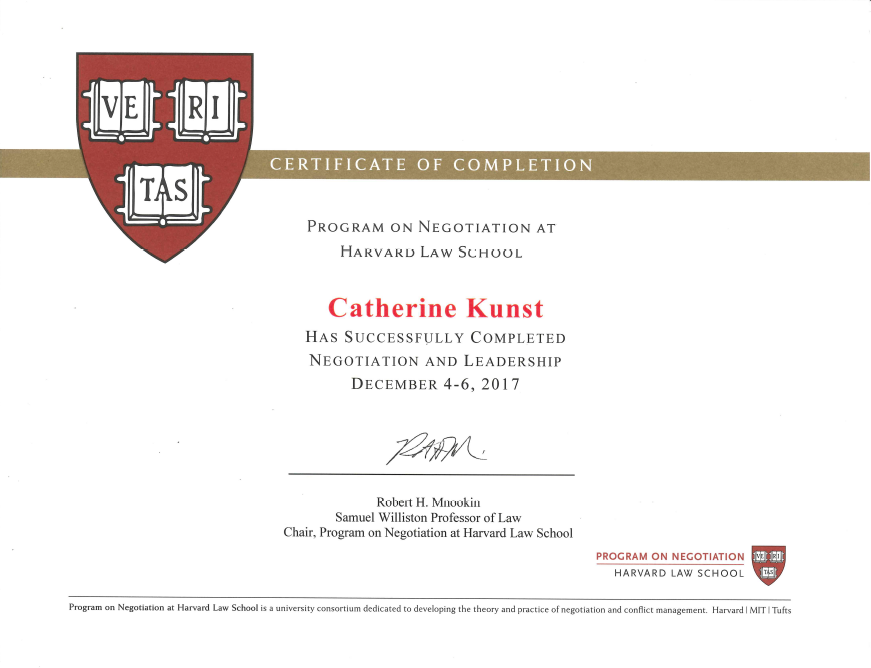Day 3: Harvard PON – Negotiation & Leadership

Last week I attended the Harvard Law School Program on Negotiation (PON) 3 day course – Negotiation and Leadership – Dealing with Difficult People and Problems. I’ve already written up a summary of Days 1 & 2: Harvard PON – Negotiation & Leadership.
The goal of Day 3 seemed to be to tie the concepts from Day 1 and Day 2 together.
Day 3: Organizational Obstacles and other Complicating Factors
Speaker: Brian Mandell (bio)
We started with a review of what constitutes a “Good Negotiation Outcome”
- Is better than our BATNA
- Satisfies interests – ours, theirs, others’
- Is the best of many options
- Is based on legitimate criteria (e.g. 3rd party tested, Kelly Blue book, etc.)
- Includes realistic, well-planned commitments
- Is reached efficiently through effective communication
- Helps build a good working relationship
We were reminded of the importance of preparation (“hope is not a strategy!”), especially in terms of focusing on the decisions the other side needs to make. If we were them, would we accept the proposal? What are our blind-spots? Are we aware of the behaviors we make that annoy or break trust in a negotiation?
In every negotiation preparation should involve looking at the (1) structure (scope), (2) context (circumstances), and (3) people (relationships) in terms of (1) diagnosing, (2) managing and (3) shaping the overall negotiation. Easier to say than to do.
A mutual gains approach (seems like a fancy way to say “win – win”) was recommended that involved many of the themes we explored on Days 1 and 2 – using empathy, problem solving and fact finding together, accepting responsibility, admitting mistakes, sharing power, being trustworthy, and building long term relationships.
There were two case studies/role playing exercises. The first involved an internal negotiation around a budget increase for a departmental unit that deviated from the proposed norms. For this exercise we used a “Quick Negotiation Preparation Sheet” – a single sided 8.5 x 11 abbreviated version of the tool we’d used on Day 2. These tools are perhaps some of the best takeaways from the program in terms of the general applicability to disparate situations. I’ve already generated my own version of this one to use at work. They are intuitive, straightforward to use, and remind you to not neglect key interests and goals of the various parties.
The second exercise was harder, as it involved 3 people, disparate power positions where coalitions could form between any two parties, and variable rewards depending how an agreement was negotiated. Every part of the negotiation had to be open to all parties, even when two parties were colluding together. There were about 60 groups doing the exercise, and we probably came up with 20+ different outcomes for this very simply exercise. It really dug into personal perceptions of fairness and the numerical differences between EQUAL and EQUITABLE.
Day 3: Negotiation and Leadership: Putting it all Together
Speaker: Guhan Subramanian (bio)
I think we were all exhausted at this point. The role playing exercises stopped (whew!), but we worked through two case studies, including the 26 page Case Study we were given the night before.
First of all, I learned a new word – Negotiauctions – which is part of his book title “Dealmaking: The New Strategy of Negotiauctions.”
He defines Negotiations in this short video.
He did a fantastic job of tying everything together and keeping us engaged for the final few hours of the program.
Case study one was based on real data from a famous workplace tragedy that was transformed to be relevant to a related but different industry. Because of how the data (and stories of the various stakeholders) was presented in small bits over time, versus having all of the data at once, people became very entrenched in their initial albeit mostly wrong points of view. At the core this was a “go” or “no go” decision. A good 90% of our group kept locked to a “go” decision. A handful of us were less risk tolerant, and recommended “no go” based on the data, even at a known significant financial risk. As more data was revealed, those of us who were less risk tolerant, became more confident in our “no go” positions whereas only a handful of the “go” group switched to our point of view. And then the underlying case, the real life example, was revealed. This was a very powerful lesson. And frankly real life is filled big life changing decisions that need to be made with incomplete data, and no time to get more details.
Case study two was another real life example of negotiating decisions made by a CEO during a very complex negotiation – Fairstar Heavy Transport. Summary from the link provided: In 2009, the small heavy marine transport company Fairstar entered into bidding on one of the largest contracts in the history of the industry. The case chronicles the company’s year-long tendering process, leading up to a final make-or-break meeting. This case was fascinating given the various interests of the different parties (e.g. investors, the negotiating companies, individuals, industry competitors, etc.) and the now known real-life outcomes for the various stakeholders.
I could not be more enthusiastic about recommending this program. The Harvard Law School Program on Negotiation (PON) 3 day course – Negotiation and Leadership – Dealing with Difficult People and Problems will be offered again in 2018 in April (16-18), May (14-16) and June (18-20).
You should go!